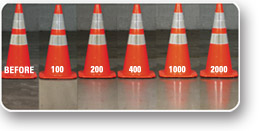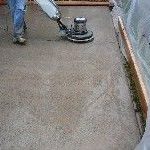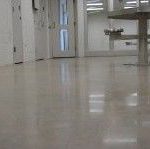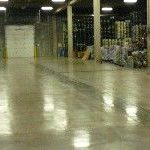Grinding Concrete:
Grinding concrete is usually the first step to a rejuvenated floor. The level of grinding will depend on the condition of your concrete or terrazzo floor. Floors that have more wear will require more grinding. Grinding a floor will remove the top layer and get rid of any seals or coatings on the floor. It will also prepare the floor for the polishing stages. This is the most critical step in the process and will usually take the longest to do. Giving the concrete a proper grind will remove much of the dirt and dust that has built up over the years.
Grinding is done by using a diamond grit that is bonded to a metallic backing and assembled to a flexible, spring-steel blade. The flexible blade allows the diamond to remain in constant contact with the floor, maximizing the tools effectiveness. New diamond particles are continuously exposed, retaining sharp edges throughout the life of the tool. This tool abrades existing epoxy floors, effectively preparing it for the re-coat application.
All of the grinding is done wet to minimize dust and keep dust from entering the walls and ceiling. The slurry is then taken up using a wet-vac or auto-scrubber.
Polishing Concrete:
Polishing concrete is the next step in the rejuvenation process. There are several ways to go about this process. The most common way is to start by using 100 grit diamond polymer blades. These blades will start to close to the pores of the concrete. It is usually during this stage that the floor is densified and/or stained. We will continue polishing using finer grit diamonds until we reach the customers desired level of sheen. This multi-step system allows the customer the flexibility to choose how many steps are needed to achieve the desired surface finish.
We use a wet system up to 200 grit and then either continue with a wet process or move to a dry pad polish. The dry pad polish system has pads that are impregnated with diamonds to smooth the surface of the concrete. There are many levels of grit that we progress through to get the desired look for our customers. When staining it is best to use dry pads so that the stain is not disturbed by water.

Sealing Concrete:
There are many different types of sealer. Ask one of our experts to see what seal will best fit your project and floors. Depending on the nature of the project will depend on what type of seal is used to assist in protecting your concrete/terrazzo floors. We often will apply a propane or electric burnish at the end of the project to give a floor that special shine.
Burnishing Concrete:
This process is primarily used indoors and will make your concrete shine. Applying a Burnish once or twice a year will assist the life of your concrete and also acts as a way to harden the concrete. Getting set up on a yearly maintenance plan is usually the best way to protect the life of your floors.
Special Notation:
To manage the end users’ expectations, the polish will only perform according to what the concrete’s condition will allow, thus meaning that the client should consider pre-existing oil stains and other deposits. The system will not remove all VCT “shadowing.” Such pre-existing conditions may actually serve to enhance the look of the finished product, offering a one-of-a-kind look that can not be duplicated.




